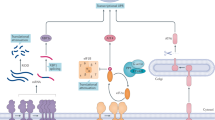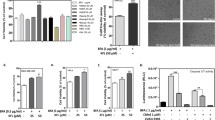Abstract
Misfolded or unfolded proteins are accumulated in lumen of endoplasmic reticulum (ER) in ER stress condition. It has been implicated in many pathological conditions such as Alzheimer’s disease, diabetic retinopathy, atherosclerosis, β-cell apoptosis and lung inflammation. We found a series of N-substituted-2-arylcarbonylhydrazinecarbothioamides to potently decrease ER stress signal, showing up to almost 300-fold better activity than 1-hydroxynaphthoic acid and tauro-ursodesoxycholic acid, positive controls, respectively. Structure−activity relationship (SAR) study showed that 2-arylcarbonyl moiety is critical for the activity of the hydrazinecarbothioamide analogues and side chains tethering on thioamide moiety were relatively insensitive to the activity. Some analogues were found to consistently exert the potency under more physiologically relevant condition where ER stress was induced by palmitic acid. ER stress markers such as CHOP and phosphorylated eIF2α and PERK were accordingly decreased in western blotting upon treatment of compound 4h. Potential ER stress inhibitory activity and novel structures could provide a novel platform for new chemical chaperone and therapy for protein misfolding diseases.




Similar content being viewed by others
References
Ainsworth C (1960) 1,2,4-triazole. Org Synth 40:99
Boyce M, Bryant KF, Jousse C, Long K, Harding HP, Scheuner D, Kaufman RJ, Ma D, Coen DM, Ron D, Yuan J (2005) A selective inhibitor of eIF2a dephosphorylation protects cells from ER stress. Science 307:935–939
Harding HP, Zhang Y, Zeng H, Novoa I, Lu PD, Calfon M, Sadri N, Yun C, Popko B, Paules R, Stojdl DF, Bell JC, Hettmann T, Leiden JM, Ron D (2003) An integrated stress response regulates amino acid metabolism and resistance to oxidative stress. Mol Cell 11:619–633
Harding HP, Zhang Y, Ron D (1999) Protein translation and folding are coupled by an endoplasmic-reticulum-resident kinase. Nature 397:271–274
Haze K, Yoshida H, Yanagi H, Yura T, Mori K (1999) Mammalian transcription factor ATF6 is synthesized as a transmembrane protein and activated by proteolysis in response to endoplasmic reticulum stress. Mol Biol Cell 10:3787–3799
Heifetz A, Keenan RW, Elbein AD (1979) Mechanism of action of tunicamycin on the UDP-GlcNAc:dolichyl-phosphate Glc-NAc-1-phosphate transferase. Biochemistry 18:2186–2192
Hetz C, Chevet E, Harding HP (2013) Targeting the unfolded protein response in disease. Nat Rev Drug Disco 12:703–719
Iannitti T, Palmieri B (2011) Clinical and experimental applications of sodium butyrate. Drugs R D 11:227–249
Jeong KW, Ku JM, Park MW, Park SM, Yang JE, Nam TG (2013) Hydroxynaphthoic acids identified in a high throughput screening potently ameliorate endoplasmic reticulum stress as novel chemical chaperones. Chem Pharm Bull 61:740–746
Munch H, Hansen JS, Pittelkow M, Christensen JB, Boas U (2008) A new efficient synthesis of isothiocyanates from amines using di-tert-butyl dicarbonate. Tetrahedron Lett 49:3117–3119
Ozcan U, Yilmaz E, Ozcan L, Furuhashi M, Vaillancourt E, Smith RO, Görgün CZ, Hotamisligil GS (2006) Chemical chaperones reduce ER stress and restore glucose homeostasis in a mouse model of type 2 diabetes. Science 313:1137–1140
Papa FR (2012) Endoplasmic reticulum stress, pancreatic β-cell degeneration and diabetes. Cold Spring Harb Perspect Med 2:a007666
Papp E, Csermely P (2006) Chemical chaperones: mechanisms of action and potential use. In: Starke K, Gaestel M (eds) Molecular chaperones in health and Disease. Handbook of experimental pharmacology, vol 172. Springer, Berlin, Heidelberg, p 405–416
Park SM, Choi J, Nam TG, Ku JM, Jeong K (2016) Anti-diabetic effect of 3-hydroxy-2-naphthoic acid, an endoplasmic reticulum stress-reducing chemical chaperone. Eur J Pharm 779:157–167
Oruç EE, Rollas S, Kandemirli F, Shvets N, Dimoglo AS (2004) 1,3,4-thiadiazole derivatives. Synthesis, structure elucidation, and structure-antituberculosis activity relationship investigation. J Med Chem 47:6760–6767
Walter P, Ron D (2011) The unfolded protein response: from stress pathway to homeostatic regulation. Science 334:1081–1086
Xu C, Bailly-Maitre B, Reed JC (2005) Endoplasmic reticulum stress: cell life and death decisions. J Clin Invest 115:2656–2664
Acknowledgements
This research was supported by Research Fund of Hanyang University (HY-2013-P).
Author information
Authors and Affiliations
Corresponding authors
Ethics declarations
Conflict of interest
The authors declare that they have no conflict of interest.
Additional information
Publisher’s note Springer Nature remains neutral with regard to jurisdictional claims in published maps and institutional affiliations.
Supplementary Information
Rights and permissions
About this article
Cite this article
Choi, H., Yun, W., Lee, Jh. et al. Synthesis and anti-endoplasmic reticulum stress activity of N-substituted-2-arylcarbonylhydrazinecarbothioamides. Med Chem Res 28, 2142–2152 (2019). https://doi.org/10.1007/s00044-019-02442-1
Received:
Accepted:
Published:
Issue Date:
DOI: https://doi.org/10.1007/s00044-019-02442-1




